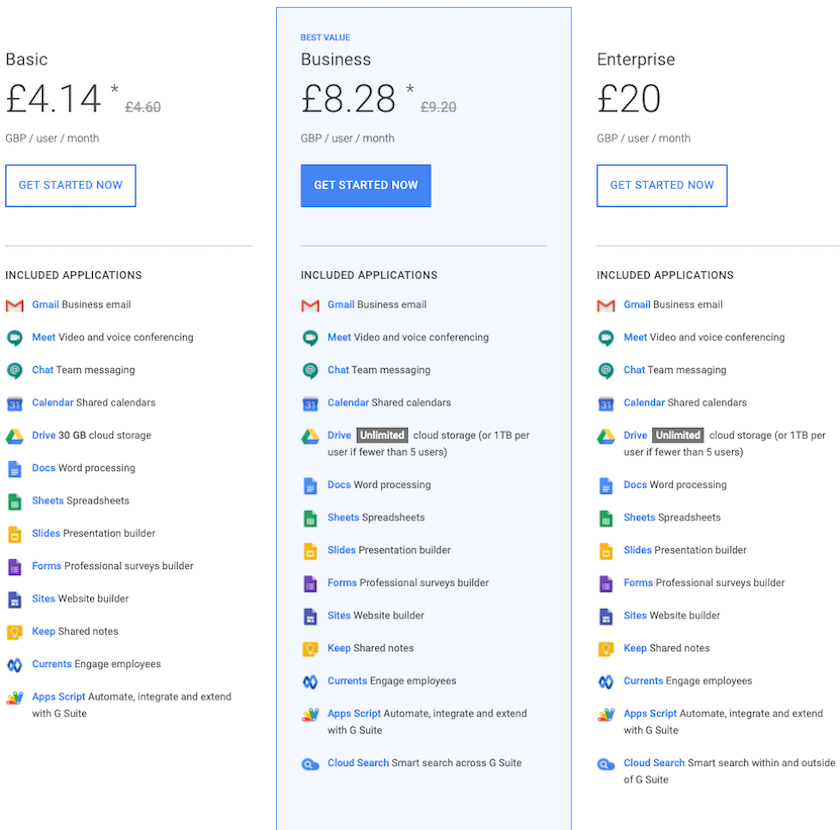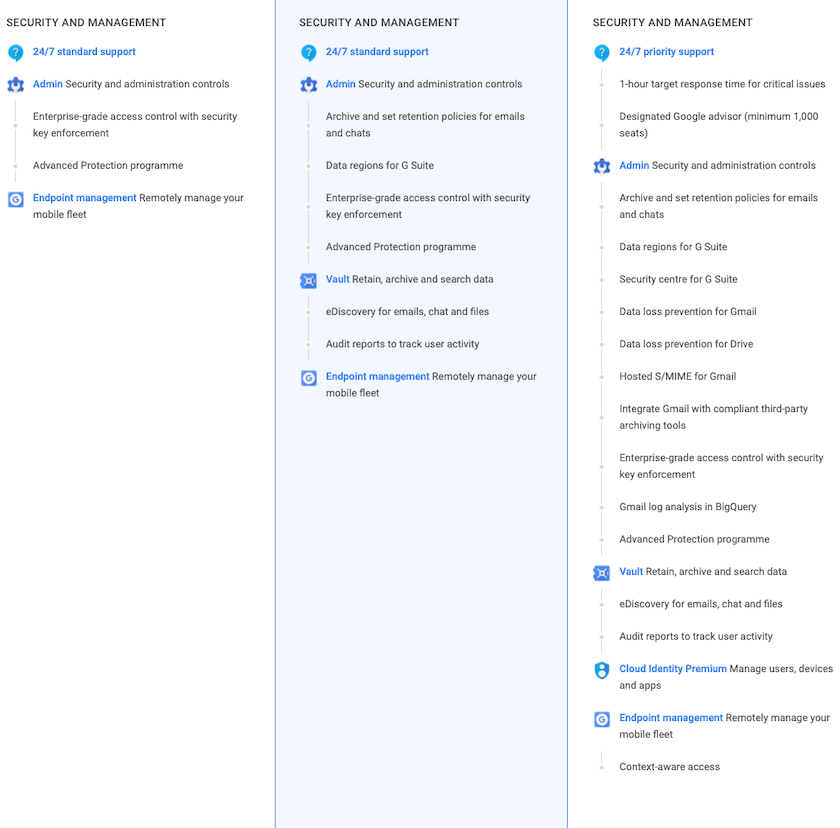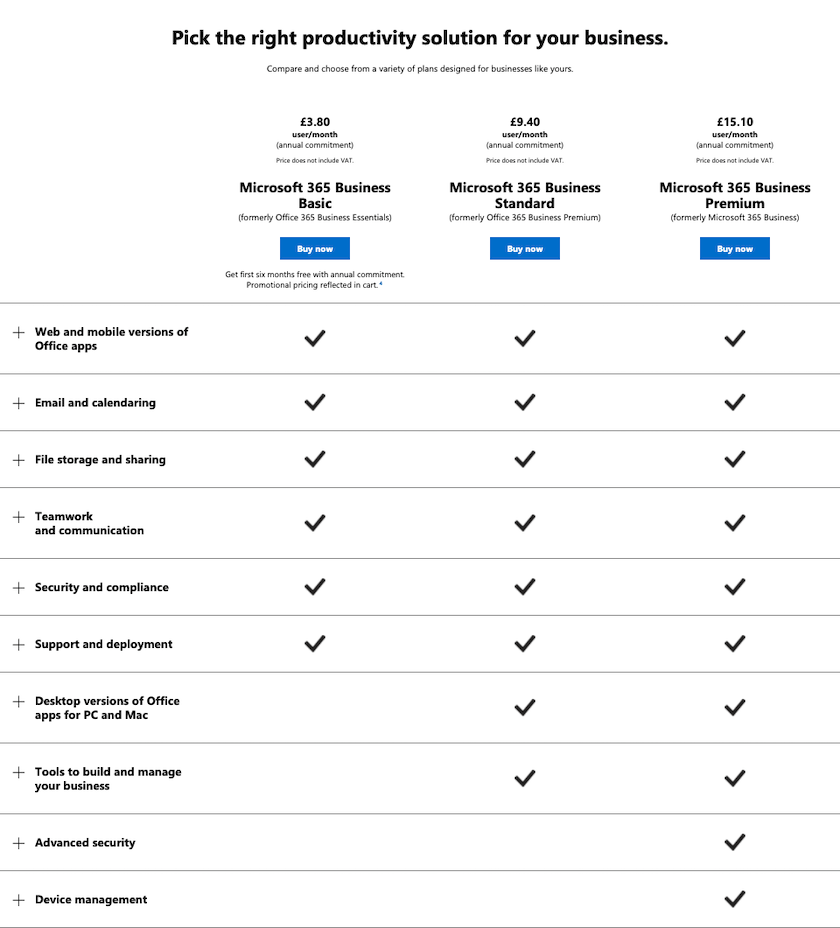G Suite vs Office 365, which is better for your business?
As far as cloud-based productivity tools go, Google’s G Suite and Microsoft Office 365 are probably the ones you’ve heard talked about most. They certainly are the most used by businesses around the world. Microsoft Office, which has arguably dominated the world of business technology since its inception, announced just last October that it had over 200 million active Office 365 users a month! Its rival sibling, Google, however, is climbing up the ranks at a rapid rate, with more than 5 million paying businesses using G Suite – and 1 million new customers signed up just last year alone! But can G Suite replace Office 365 in popularity?
Both services have a lot in common, which makes the decision between the two even more difficult for your business! Yet each app works differently, and each system has different tools that work alongside them. Before we dive deeper into the pros and cons of G Suite and Office 365 for both large and small businesses, let’s take a look at what each system does.
What is the difference between G Suite and Office 365?
Both G Suite and Office 365 are productivity tools that provide cloud storage. Among their services each provide businesses word processing, spreadsheets, presentation, email, calendar, contact, video conferencing, messaging, and note-taking tools. It’s quite a list!
So, what do they offer? Both work on Android and iOS, as well as on and offline (the difference being that G Suite is web-based but can be used offline, whereas Microsoft 365 is typically locally installed, but also has web-based versions). They also both have great mobile device functionality. If you’re a small business weighing up the pros and cons of the two tools, both G Suite and Office 365 offer plans for small businesses, and these are priced based on the numbers of users – so you pay based on the size of your company.
Now that we’ve established what they do, let’s have a look at the differences.
- Features of G Suite and Office 365
- G Suite vs Office 365 Storage
- Security with Google and Microsoft
- G Suite and Office 365 pricing
- G Suite or Office 365 Comparison Chart
Which is better, G suite or Office 365?
What different features does Office 365 have vs G Suite?
To best understand the features, we’ll compare individual apps. You’re probably familiar with Microsoft’s applications: Word, Outlook, Excel, PowerPoint, Publisher, OneDrive, One Note and Skype. G Suite has similar applications that go by the names of Gmail, Google Drive, Google Docs, Sheets, Slides, Calendar, Keep, and Hangouts. Let’s break down some of the main applications further.
Word processing (Google Docs vs Word)
Google Docs
Word is probably the most known application across Microsoft and Google. Google Docs, however, has come in as its rival, offering users a simple format and an easily transportable tool as it’s web-based. When comparing it to Word, it is, without a shadow of a doubt, far superior in terms of live collaboration. Multiple users can seamlessly work on the same document simultaneously, and the commenting and activity tracking features far outweigh that of Word. This is, however, where the superiority ends.
Word
With all of its updates throughout the years, Word is the absolute winner for the rest of its features. With nearly 50 templates to Google Docs’ 5, Word is a far easier tool to use to draft a huge variety of documentation. While the collaborative elements of Google Docs’ commenting is an excellent feature, it still has a long way to go to challenge Word’s review process. The activity tracking on Word may be more complicated, but the mark-up process allows for more sophisticated and informative editing.
Winner: Office 365
Spreadsheet (Google Sheets vs Excel)
In a similar way to word processing, if you care more about a collaborative space than specific technical features, Google Sheets has exceptional integrated collaboration and commenting. When it comes to the technical parts however, Excel remains a trusted aid. Where Google Sheets has 3 templates, Excel wipes the floor with an incredible 60 templates. Similarly, charts are far easier to create in Excel and offer 17 different types, whereas Sheets has a much smaller range, with 7.
Winner: Office 365
Email (Gmail vs Outlook)
This may be where the biggest battle arises! Gmail offers a far simpler and less cluttered tool than Outlook. It also has a built-in AI functionality that suggests words as you type, making the email writing process easier and far quicker. If you’re guilty of delayed responses to emails, you’ll also benefit from the incredibly useful ‘nudge’ function which offers you email response reminders. Perhaps the most useful for productivity, Gmail also allows you to ‘snooze’ incoming emails so that your work is not disturbed. Outlook does offer greater integration in terms of calendar and contacts, a ‘focused’ inbox for email prioritisation, as well as the ability to simplify long email threads with the ‘clean up’ tool. Gmail’s other features, however, do outshine these otherwise fantastic functions.
Winner: G Suite
Presentation (Google Slides vs PowerPoint)
Aside from Google Slides’ collaboration abilities, as with Docs and Sheets, it doesn’t seem to match up to PowerPoint with its other features. PowerPoint offers higher quality and easier graphics and transitions, more charts and tables, and much like Word and Excel, there are far more templates to choose from, making the presentation creating phase far quicker and more comprehensive.
Winner: Office 365
While these are just a few of the applications, they are certainly the most used. With this analysis you can get more of a picture of the underlying themes of the two tools: G Suite is a fantastic collaboration tool, whereas Office 365 offers more high-quality features.
It’s also worth bearing in mind that while both tools work online, G Suite is largely web-based with offline functionality (it doesn’t have desktop apps to download), while Office 365 is predominantly installed on the desktop, but does have web-based functionality. It’s important to highlight this as they have different uses; G Suite may be more useful for workers that move around and change devices, whereas Office 365 is easier and quicker to access with pre-installed applications that sync to the cloud.
Overall Winner: Office 365
G Suite vs Office 365 Storage
General storage
Fortunately, both systems have substantial storage. With G Suite, this depends on the plan you choose: with a basic business plan you’ll receive 30 GB of storage, which is then increased to unlimited storage with the more expensive packages. Office 365, however, offers 1TB of storage for all of its plans! While it is capped to 1TB, this is a significant amount. If you’re a small business, therefore, you’ll receive 333x more storage with the more basic plan on Office 365 than with G Suite!
Search capabilities
In terms of using your stored documents, the search functionality with G Suite is as great as would be expected from the world’s leading search engine! Its shortfall in comparison to OneDrive, however, is OneDrive’s superior web browsing capabilities.
Email storage
Similarly, with email storage, G Suite offers an extra 30GB of email storage on top of your 30GB basic storage, whereas Office 365 you’ll get an additional 50GB for your mailbox with the basic packages. Similar to the main storage function, this becomes uncapped with G Suite, whereas Office 365 simply offers another 1TB with the higher paid plans. Their solution to this, however, is unlimited auto-expanding archiving for older messages.
Winner: Office 365
Security with Google and Microsoft
Security is one of the biggest concerns when it comes to anything technology-based, particularly if you’re a small business. When weighing up G Suite’s vs Office 365’s security features, it can be difficult to discern which is best – they both seem to have comprehensive security! Let’s examine this closer.
G Suite:
- Detects suspicious activity, phishing and hacking attempts automatically
- Data leak protection
- Built-in spam software
- Built-in antivirus software
- Malware detection for all documents and attachments
- Multi-factor authentication
Office 365:
- Use their own AI tools which map user’s typical work habits to inform their suspicious activity detection
- Data loss prevention against leaks and theft
- Option to restrict access for only company-owned devices.
- Built-in spam software
- Built-in antivirus software
- Malware detection for all emails, documents and attachments
- Multi-factor authentication
When it comes to security, both platforms offer robust measures. Google Workspace provides multi-factor authentication and automatic spam detection, while Microsoft 365 enhances its security with advanced threat protection, data loss prevention, and compliance tools. Understanding these features is crucial in choosing the right platform for your business.
Winner: Office 365
For more information on how your company can improve its network security, get in touch with a member of the Netitude team for more information on our Cyber Security Services.
G Suite and Office 365 pricing
Now, the bit you’ve likely been waiting for: pricing. Both products can be used for free, yet it’s highly recommended for businesses to use the paid-for plans for better management and cyber safety.
In order to compare the price plans in more depth, it’s worth taking a closer look at what each subscription entails.
G Suite:
As you can see in the pricing comparison charts below, G Suite offers 3 plans for businesses: Basic, Business, and Enterprise. As a quick summary: with the Basic plan you’ll receive all apps other than Cloud Search, and 30GB of storage for £4.14 a month; with the Business plan you’ll receive all of the above as well as unlimited storage, Cloud Search and more security and management tools for £8.28 a month; with the Enterprise plan you’ll receive all of the above, and even greater security and management tools for £20 a month.


Office 365:
Similarly, 365 offers 3 business plans: Business Basic, Business Standard, and Business Premium. Each option offers 1TB of storage, web and mobile apps, emails and calendars, access to Teams, and comprehensive security and compliance features. What differs the Business Standard package from the Business Basic is the ability to install the desktop applications onto PC and Mac, as well as integrated planning tools. Premium goes one step further, with even more advanced security features and device management.
So, which is cheaper? Sadly, you can’t put Office 365 Business pricing against G Suite in a comparison chart. Each package offers different tools and capabilities for different prices. As a small business, however, it seems that Office 365 offers a cheaper functionality, without the worry of using all of your storage, as with G Suite. For larger businesses, the plans offer very similar packages in terms of security and management controls, so ultimately, Office 365 may also work out cheaper, even if you might need to buy extra storage.

Winner: Office 365
So, that was a lot of comparison to process! To summarise let’s break it down into a quick table:
| G Suite | Office 365 | |
| Features |
|
|
| Storage |
|
|
| Security |
|
|
| Pricing |
|
|
For more detailed comparisons, refer to NinjaOne Blog and StyleFactoryProductions.



The Netitude Choice: Microsoft Office 365
So, you should be clearer on which productivity tool will work best for your company! We believe that Office 365 is the overall winner, which is why we recommend it to all of our clients here at Netitude. If you, like us, are won over by Office 365’s features and benefits but aren’t sure how to change from your current platform, get in touch to speak to one of our experts! We specialise in Microsoft 365 migrations and would be more than happy to help.